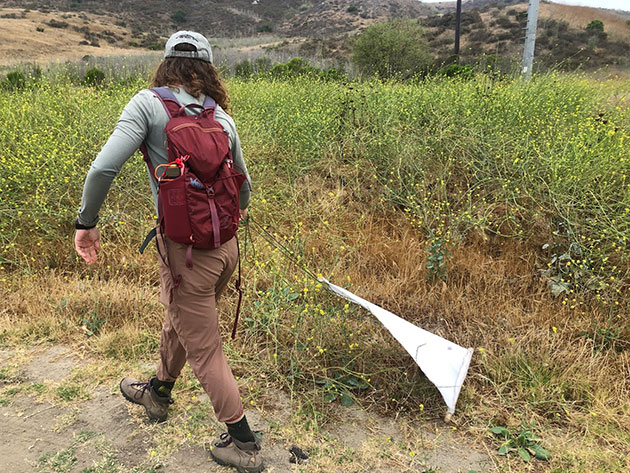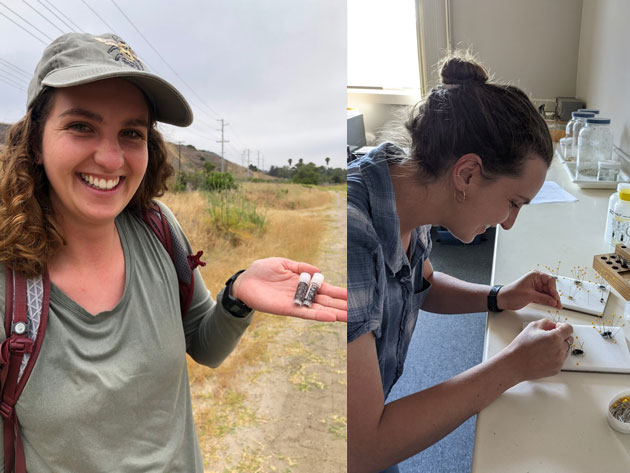



Sierra Teemsma was a student at San Diego City College trying to find her passion, something that would inspire her to make a profession out of. But nothing was becoming obvious. Completing various courses off-and-on while working full time in fast food, she just could not find academic motivation.
“I was taking classes – nursing, sociology, science – but I didn’t have a clear goal of what I wanted to do as a career,” Teemsma says. “Everything was interesting, but nothing seemed like something I wanted to dedicate my life to.”
Then she discovered bugs. No, not like bugs in programming but actual insects.
“I realized that entomology was an actual major and it was something you could really explore and learn deeper and you could apply concepts learned in a biology or chemistry class to insects specifically.”
Finally landing on an academic focus where she could “play with bugs,” Teemsma started taking more science classes – which she admits, “were really difficult.” But she realized she could get more comfortable with the subject through some hands-on experience, landing a job as a bee wrangler at Bee Man Dan in Escondido, CA. There, Teemsma worked with live, stinging insects, removing beehives from problematic areas as an alternative to extermination.
Since then, she transferred to the University of California, Davis, worked in San Diego Natural History Museum’s Entomology collection, and volunteered at the Bohart Entomology museum. She even helped describe a species of leaf insect, for which she was credited as co-author on an academic research paper with Royce Cumming, a PhD student at City University of New York. They identified a new species in an old collection that had been undescribed up to now, solving a century-old mystery in the process.
“Many new species don’t come from going out in the field but are sitting in museums unclassified or incorrectly classified,” she explains.
One experience on her resume that stands out for Teemsma: her 2021 NREIP internship at Navy Environmental and Preventive Medicine Unit 5 in San Diego. While most people might not think of a Navy lab as the right place to get field experience in entomology, it’s an important area of research. Bases, like anywhere else, are susceptible to infestations. Personnel can be put at risk of insect-borne diseases. Ships might find themselves under attack by these much smaller enemies. For each of those cases, researchers are interested in identification and prevention, in which Teemsma participated. There was also surveilling and managing problems, such as those related to San Diego’s mosquito population.
When Teemsma talks about her experience, she is especially effusive about learning and then passing on that that knowledge. She helped curate and update the lab’s own collection and participated in workshops for Navy personnel on how to identify and manage real-world problems, such as how to keep ship galley kitchen supply from becoming infested.
“Coming in as an entomology student, I had a pretty good idea about butterflies and beetles, but I learned a lot more about other, medically important insects,” she explains. “For example, I wasn’t really familiar with different types of mosquitoes, but working with [NREIP] entomologists, I learned how to identify ticks and mosquitoes and other stored product pests.”
Teemsma also acquired advanced skills such as learning how to extract DNA. Teemsma and her NEMPU5 team collected ticks in the field and took them back to the lab to determine their species through morphological and molecular pathways, and then see if they carried Rickettsial pathogens that cause Rocky Mountain Spotted Fever, a potentially deadly disease spread by tick bites. Entomologists are worried about it crossing the border from Mexico where it has been declared an epidemiologic emergency.
“Learning how to extract DNA just sounds cool, but it also directly relates to what I am doing,” Teemsma says about the experience. “Being able to say, ‘DNA extraction, yeah, I’ve done that,’ has really built my confidence. And, entomologically speaking, medical entomology has got me hooked.”
None of this, she says, would have been possible without the resources she had access to, especially the guidance from researchers at the NEMPU5 lab.
“NREIP provided me the tools, lab space and mentorship needed to cultivate my research interests in a professional environment. As an NREIP intern I found purpose in my work and a community to learn from. Mentorship from brilliant, kind, Navy Medical entomologists showed me this path, major, career, is worth it and can be incredibly rewarding and so much fun. I got to ask questions and work alongside experts, who were also eager to teach and produce tangible work.”
Teemsma isn’t sure where her career will take her and says she’s not sure if it will lead to “a career in the Navy specifically, but learning Navy culture and experiencing its traditions definitely makes this employer standout.”